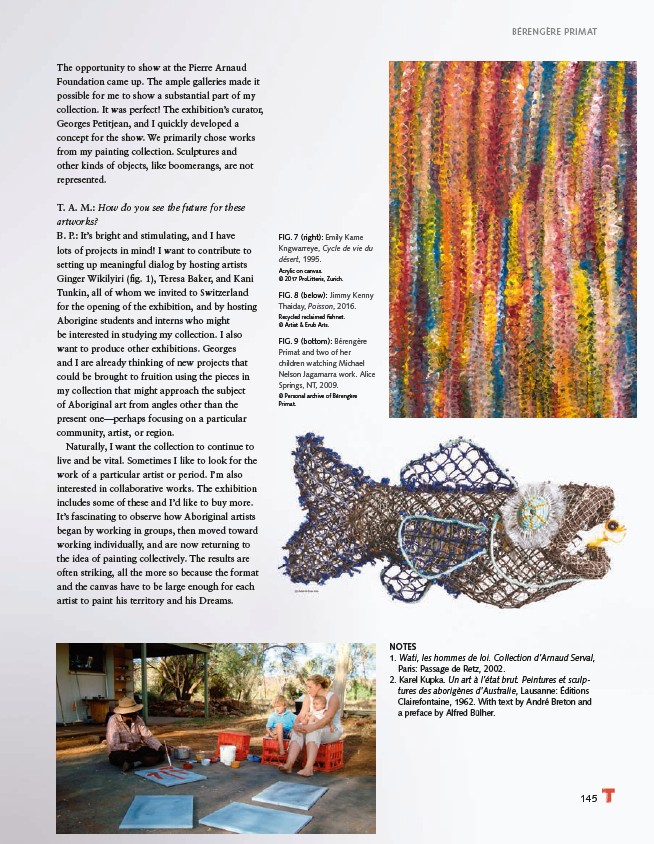
NOTES
1. Wati, les hommes de loi. Collection d’Arnaud Serval,
Paris: Passage de Retz, 2002.
2. Karel Kupka. Un art à l’état brut. Peintures et sculptures
des aborigènes d’Australie, Lausanne: Éditions
Clairefontaine, 1962. With text by André Breton and
a preface by Alfred Bülher.
145
FIG. 7 (right): Emily Kame
Kngwarreye, Cycle de vie du
désert, 1995.
Acrylic on canvas.
© 2017 ProLitteris, Zurich.
FIG. 8 (below): Jimmy Kenny
Thaiday, Poisson, 2016.
Recycled reclaimed fishnet.
© Artist & Erub Arts.
FIG. 9 (bottom): Bérengère
Primat and two of her
children watching Michael
Nelson Jagamarra work. Alice
Springs, NT, 2009.
© Personal archive of Bérengère
Primat.
The opportunity to show at the Pierre Arnaud
Foundation came up. The ample galleries made it
possible for me to show a substantial part of my
collection. It was perfect! The exhibition’s curator,
Georges Petitjean, and I quickly developed a
concept for the show. We primarily chose works
from my painting collection. Sculptures and
other kinds of objects, like boomerangs, are not
represented.
T. A. M.: How do you see the future for these
artworks?
B. P.: It’s bright and stimulating, and I have
lots of projects in mind! I want to contribute to
setting up meaningful dialog by hosting artists
Ginger Wikilyiri (fig. 1), Teresa Baker, and Kani
Tunkin, all of whom we invited to Switzerland
for the opening of the exhibition, and by hosting
Aborigine students and interns who might
be interested in studying my collection. I also
want to produce other exhibitions. Georges
and I are already thinking of new projects that
could be brought to fruition using the pieces in
my collection that might approach the subject
of Aboriginal art from angles other than the
present one—perhaps focusing on a particular
community, artist, or region.
Naturally, I want the collection to continue to
live and be vital. Sometimes I like to look for the
work of a particular artist or period. I’m also
interested in collaborative works. The exhibition
includes some of these and I’d like to buy more.
It’s fascinating to observe how Aboriginal artists
began by working in groups, then moved toward
working individually, and are now returning to
the idea of painting collectively. The results are
often striking, all the more so because the format
and the canvas have to be large enough for each
artist to paint his territory and his Dreams.
BÉRENGÈRE PRIMAT